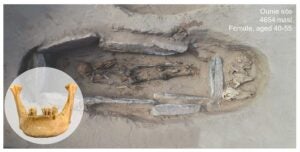In the non-arable region of the Tibetan Plateau — also known as Earth’s “third pole” — new research shows that populations relied on dairy to survive much earlier than thought: as much as 2,000 years earlier than previous historical sources, in fact.
The research, published in Science Advances, revealed that dairy pastoralism began on the highland plateau by about 3500 years ago and may have been key to long-term settlement of the region’s extreme environment.
The scientific team found that dairying was a critical cultural adaptation that supported expansion of the early pastoralists into the region’s vast, non-arable highlands, opening the Tibetan Plateau up to widespread, long-term human occupation.
The role of biological and agricultural adaptations that enabled early human colonisation of the plateau has been widely discussed.
“These included genetic adaptations that allowed Tibetans to use smaller amounts of oxygen more efficiently,” said Li Tang, a Ph.D. candidate who led the research. “But the contribution of pastoralism to the settlement of Tibet is less well understood, especially the dairy pastoralism that has historically been central to Tibetan diets.”
The researchers used palaeoproteomic techniques to analyse ancient milk proteins preserved in the dental calculus of 40 human individuals from 15 ecologically diverse sites in Tibet and western Qinghai.
Dental calculus provides a direct source of ancient dietary information on individual humans because food proteins and other substances become trapped in the calcified matrix during its formation. This matrix can help to stave off processes of decay, supporting long-term preservation of ancient biomolecules from certain foods like milk.

Investigating the amino acid sequences of some milk proteins revealed that these ancient humans sourced their dairy resources from sheep, goat, and possibly cattle and yak.
“Our findings indicate that dairying was introduced onto the interior Tibetan Plateau by at least 3500 years ago, more than 2000 years earlier than recorded in historical sources,” said Professor Nicole Boivin of the Max Planck Institute for the Science of Human History.
This timing coincides with the earliest archaeologically identified domesticated ruminant bones on the interior plateau, indicating that dairying was probably adopted as soon as pastoralism spread into this region.
“Understanding how ancient populations obtained sufficient food to survive in these agriculturally marginal highlands is key to understanding the long-term economic and demographic, as well as land-use development of the Tibetan Plateau,” Li Tang said.


